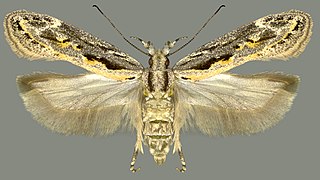Related Research Articles

The willow flycatcher is a small insect-eating, neotropical migrant bird of the tyrant flycatcher family. There are four subspecies of the willow flycatcher currently recognized, all of which breed in North America. Empidonax flycatchers are almost impossible to tell apart in the field so biologists use their songs to distinguish between them. The binomial commemorates the Scottish zoologist Thomas Stewart Traill.

The genus Tamarix is composed of about 50–60 species of flowering plants in the family Tamaricaceae, native to drier areas of Eurasia and Africa. The generic name originated in Latin and may refer to the Tamaris River in Hispania Tarraconensis (Spain).

Tamarix aphylla is the largest known species of Tamarix. The species has a variety of common names, including Athel tamarisk, Athel tree, and Athel pine. It is an evergreen tree, native across North, East and Central Africa, through the Middle East, and into parts of Western and Southern Asia.

Tamarix gallica, the French tamarisk, is a deciduous, herbaceous, twiggy shrub or small tree reaching up to about 5 meters high.

Tamarix chinensis is a species of tamarisk known by the common names five-stamen tamarisk and Chinese tamarisk or saltcedar. It is native to China and Korea, and it is known in many other parts of the world as an introduced species and sometimes an invasive noxious weed. It easily inhabits moist habitat with saline soils. It may grow as a tree with a single trunk or as a shrub with several spreading erect branches reaching 6 metres or more in maximum height. It has been known to reach 12 metres. It has reddish, brown, or black bark. The small, multibranched twigs are covered in small lance-shaped, scale-like leaves which are no more than about 3 mm long. The inflorescence is a dense raceme of flowers a few cm long. Each fragrant flower has five petals which are usually pink but range from white to red.
Agdistis tamaricis is a moth of the family Pterophoridae found in Africa, Asia and Europe. It was first described by the German entomologist, Philipp Christoph Zeller in 1847.
Ascalenia pachnodes is a moth in the family Cosmopterigidae. It has been recorded from Nubia and India (Bengal).

The Negev shrew, also known as the Ramon's shrew is a species of mammal in the family Soricidae. So far, it is only known from Israel. It is found in three regions: Mizpe Ramon and Sede Boqer in the Negev Desert, and Sartaber at the northern edge of the Judean Desert. It is likely that the species occurs more widely in the region than currently known. The three locations in which the species occur are rocky desert areas at altitudes between 200 and 950 metres above sea level. The Negev shrew is light gray with a slightly lighter underpart. It is also relatively small.
Deserticossus arenicola is a species of moth of the family Cossidae. It is found in Russia (Dagestan), Armenia, Azerbaijan, Georgia, Turkmenistan, Kazakhstan, Uzbekistan, Kyrgyzstan, north-western China, Iran, Afghanistan, Pakistan, Egypt (Sinai) and Jordan.

Ornativalva plutelliformis is a moth of the family Gelechiidae. It was described by Staudinger in 1859. It is found from southern Europe and North Africa east to western Asia and China (Xinjiang).
Amblypalpis olivierella, the tamarix spindle-gall moth, is a species of moth in the family Gelechiidae. It was described by Émile Louis Ragonot in 1886. It is found in Tunisia, Algeria, Libya, the Sinai, Egypt, Israel, Jordan, northern Yemen and the United Arab Emirates, Iran, India and Pakistan.
Amblypalpis tamaricella is a species of moth in the family Gelechiidae. It was described by Aleksandr Sergeievich Danilevsky in 1955. It is found in Central Asia, where it has been recorded from Kazakhstan and western China. The habitat consists of riparian forests and deserts.
Ornativalva indica is a moth of the family Gelechiidae. It was described by Sattler in 1967. It is found in southern Iran (Luristan), Pakistan (Peshawar) and India (Bihar).
Ornativalva macrosignella is a moth of the family Gelechiidae. It was described by Sattler in 1967. It is found in Algeria, Tunisia, Egypt, Sudan, Israel and southern Iran (Luristan).
Ornativalva pseudotamariciella is a moth of the family Gelechiidae. It was described by Sattler in 1967. It is found in Portugal, Spain, Italy and southern France.
Ornativalva sesostrella is a moth of the family Gelechiidae. It was described by Rebel in 1912. It is found in Algeria, Tunisia, Egypt, Sudan, Saudi Arabia, southern Iran and Pakistan.
Ornativalva tamariciella is a moth of the family Gelechiidae. It was described by Zeller in 1850. It is found in Italy and Croatia.
Ornativalva kalahariensis is a moth of the family Gelechiidae. It was described by Anthonie Johannes Theodorus Janse in 1960. It is found in Namibia and South Africa.

Tamarix nilotica, the Nile tamarisk is a species of shrub or small tree in the tamarisk family. It is found in arid parts of North Africa and the Middle East, particularly areas with high salinity. It forms part of the dune stabilisation process.
Tamarix dioica is a twiggy shrub or small tree that grows in saline habitats in western Asia. Common names include ghaz and khagal in Pakistan, lal jhau, urusia, ban jhau, nona-gach, urichiya in Bangladesh and nona jhau in the Sunderbans.
References
| This article on a moth of the subfamily Anomologinae is a stub. You can help Wikipedia by expanding it. |